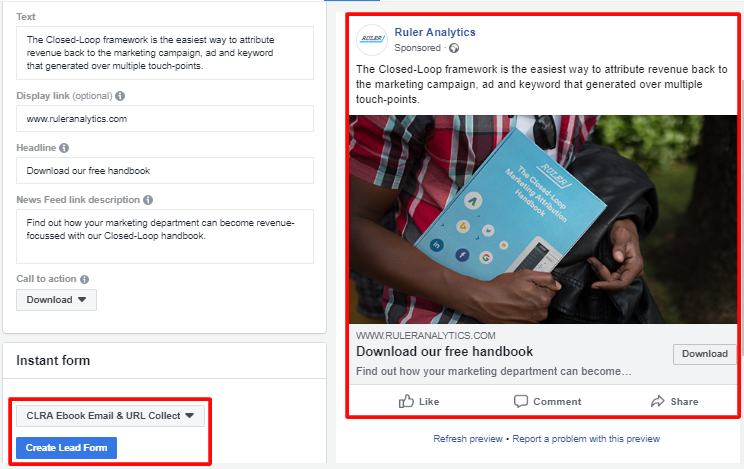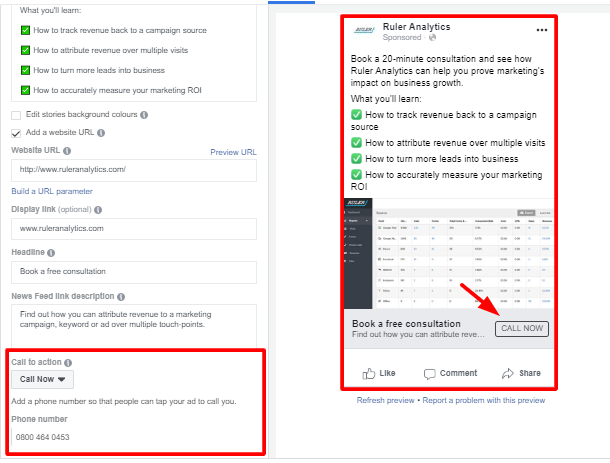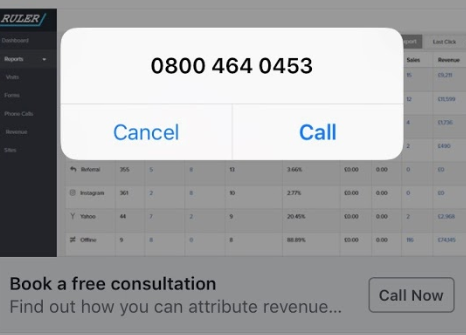With over one billion users, Facebook has the largest online presence in the world.
As such, it’s proven to be a very cost-effective means to market products and services to very select demographics.
In other words, targeting the people most likely to be interested in your brand is particularly easy with Facebook ads.
Facebook continues to evolve, which means advertisers are constantly afforded new and exciting opportunities to target new and existing customers.
However, with so many options on the table, it can sometimes be difficult for marketing teams to decide on which Facebook ad is best suited to their brand.
In this post, we’ll offer you a brief breakdown of the most popular Facebook ad types, how they function to generate a successful campaign, and how you can utilise them to generate leads and drive traffic to your site.
The idea behind lead ads is that they provide users with a more organic way to connect with the brands they might be interested in.

Instead of taking users to a landing page to fill out a lead form or provide an email address, Facebook lead ads provide customers with a means to access all your offers without having to leave the confines of the Facebook app.
These ads are designed with the user experience in mind, which means they fill out as much information as they can, including the name, phone number, address and email of a user.
This helps to save time.

When potential clients see your lead ad on Facebook, it gives them an opportunity to sign up for exclusive offers or perhaps request a free trial, demo or price guide without having to leave Facebook.
This is great for increasing conversion rates – it pays to keep things simple.
While YouTube might be the world’s premier video content network, Facebook isn’t far behind.
In fact, over 100 million hours of video are watched every day via Facebook.
Video ads allow you to show off your products in a much more dynamic way. Sound and motion are proven to draw people in, and this helps to create connections with potential customers.

Video ads are great for targeting ideal demographics and increasing brand awareness.
From here, you can even retarget prospects based on how long they watched your video for – for example, if they’re switching off after four seconds, hit them with something more concise.
People generally prefer short video ads on mobile devices – aiming for approximately 15 seconds is good practice. Don’t forget to include text or subtitles in your video, too.
Around 85% of mobile users tend to watch videos with the sound turned down (usually if they’re commuting or in a public space).
Businesses wanting to attract the attention of local customers can benefit greatly from click-to-call advertising on Facebook.

These local awareness ads will only display in the news feeds of prospective customers when they’re in close proximity to one of your business’ locations.
Facebook click-to-call ads typically come with a specific call to action, such as “book a table now” or “get directions”, prompting the user to interact with your business on a personal level.
If a user clicks the call now button, their mobile dial pad will become pre-populated with your business telephone number.

Of course, you may be wondering whether it’s worth encouraging users to call in the digital age.
After all, the information your prospects need is already at their fingertips.
While this might be the case, research has demonstrated that an increase in mobile marketing via social media has actually led to a huge increase in phone calls.
There are several reasons for this.
The main one is that people want information as quickly and easily as they can get it. Usually, the fastest way to achieve this is to call and ask the business directly.
Let’s take the example of a restaurant.
A prospect is scrolling through their Facebook feed towards the end of a working day and comes across an advert for said restaurant.
While some people might be happy to go through the rigmarole of an online booking/reservation form, most are likely to simply call up to take care of things.
At any rate, it gives the customer the opportunity to ask further questions – are there any vegan options? Does the restaurant cater to those with allergies or intolerances?
What’s today’s special?
This information is easier to get hold of in a matter of seconds with a simple phone conversation.
To ensure you’re getting a good return on investment from click-to-call ads, it’s important to understand how to properly implement call tracking.
While Facebook provides a variety of metrics on ads (total spend, number of impressions, how many people click the “call now” button) these are often a little too generalised.
To be able to paint a full picture of how your campaign is performing, you may need additional tools.
Software such as Ruler Analytics allows you to identify website visitors and attribute a source to each, therefore clearly showing you how they were brought to your page and maybe what ads aren’t driving as much traffic as others.

When a user taps “call now”, a phone call is not immediately initiated.
The dial pad opens on the user’s phone pre-populated with your business’ number, but this does not equate to an actual call.
Facebook might report it as such, but without any guarantee that a call was made.
The person could have clicked “call now” in error or decided to back-out of the dial pad without calling, that’s where analytics software will step up and report this data accurately, as it won’t record this as a call conversion because the person did not follow through.
In order to accurately measure how many calls Facebook is driving to your business, you’ll need to avail of some inbound call tracking software, such as Ruler Analytics.
With Ruler, you can track calls as well as create phone numbers specifically for each ad you publish so that when you get an inbound call, you can identify it as coming from whichever ad you assigned it to, giving you a clear indication of who’s contacting you via click-to-call.
Which is a big help when it comes to analysing which ads are performing and which ones aren’t; at the end of the day, you’ll be saving money to make money.
I recently wrote a blog about how to set up Facebook click-to-call ads which you can find here.
Many businesses first dip their toe into the world of Facebook advertising by simply boosting an existing post.
It’s the purest form of Facebook advertising, but it’s not necessarily the most effective.
Not by a long shot.

Simply boosting an ad might seem effective when you look at how many people your post is reaching, but there are some issues which can’t be denied. Firstly, it takes time to manually boost ads.
Time is your most precious resource, and if you’re looking after multiple campaigns, this can be incredibly wasteful.
Furthermore, you’ll have difficulties controlling the optimisation of your boosted ad. Your budget could end up being wasted on “engagement” – where Facebook users simply “like” your post without actually interacting with it on a meaningful level.
In addition to this, you’ll only be able to target from very basic data sets: demographics and interests.
Often referred to as multi-product ads, carousel ads are designed to do three things: increase conversion rates, improve marketing results and increase visitors to your website.
They perform up to ten times better than standard Facebook ads or “boosts”.
Carousel ads work by displaying multiple product images in the same ad window, which can be displayed on users’ news feeds on mobile or desktop.

The ad appears underneath status updates, and each item in the ad contains a title, a description and a destination link.
These ads tend to work best when combined with a custom audience list pulled from your website.
Businesses who use these ads should think wisely about what products or services to showcase – choosing your top three selling items is the best way to boost clickthrough rates.
While carousel ads may seem best suited to eCommerce platforms, they can be used to promote anything from meal deals to web seminars.
Think creatively on how best to implement carousel ads, and ask yourself if they’re the best type of ad for your
business before committing to them.
If you’re looking for a reliable way to measure how much interest your Facebook ads are generating among your audience (both on and off Facebook), you should consider using traffic ads.
They’re useful for promoting your website and pointing your target audience towards blog posts, landing pages or product information.

Traffic ads, also known as link click ads, are essentially one giant button that will send your viewers to your landing page, regardless of where they click on the ad.
This makes for an increased click-through rate, although it doesn’t guarantee an increase in ROI.
However, traffic ads are high-performing and are a good way to generate more “likes” for your Facebook business page too.
Want to decrease the distance between your brand message and your customers?
Consider canvas ads.
These ads help your business to tell the story of what you’re about in an effective, enjoyable manner for the customer.
Don’t stop at showcasing products – allow your customers to become part of your world instead.
Facebook canvas ads allow you to combine videos, photos, carousels and tilt-to-pan technology to immerse your prospects into the world of your brand.
While the amount of Facebook ad options out there might leave you feeling a little overwhelmed, always remember that with a clear plan and an outline of how much you want to spend, you shouldn’t be too far from a success.
Facebook is full of potential customers just waiting to hear about what your business has to offer – so whether you want them to call, click or engage with your post, remember to keep things simple, and try not to worry.
You’ll soon start witnessing a return on investment with the right strategy in place.